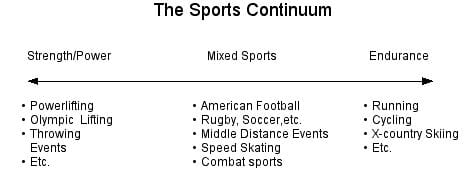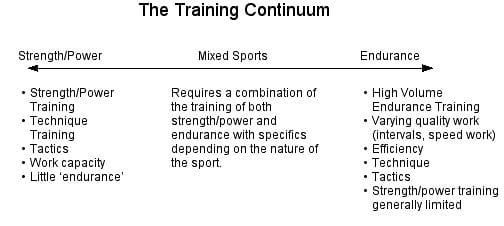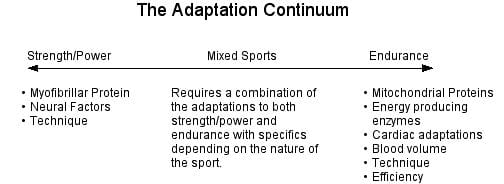Introduction
This article was motivated by couple of things:
- Me trying to figure out the training plan for the next preparatory period for my soccer club, that starts in a month
- A short e-mail discussion with Lyle McDonald regarding the problems of the mixed sports
- A lack of information available on the internet, based on my Google search. A lot of people are confused by periodization models and their application to mixed sports and their own problems, specifics and context. Or as Lyle would say: “Square peg + round hole = bad things”
The term mixed sports comes from Lyle McDonald. He recently published one article on this subject, hopefully also motivated by our short e-mail discussion.
 |
| Lyle McDonald's Sports Continuum |
Power~Capacity
 | |||
| Power~Capacity trade-off |
This concept of trade-off between Power~Capacity is also called critical power, or the average power one is able to produce for a certain time duration – the longer the duration, the lower the average power produced and vice versa. And this has a lot to do with energy systems utilized and fatigue created.
Taking Lyle’s graph (and his three group of sports), we can make the following:
 |
| Distribution of Power~Capacity in sports |
It is important to mention that different parts of the Power~Capacity continuum are inter-related (both cross in terms of correlations, and longitudinal in term of transfer). This has couple of implications.
First, positive – working on one part of the curve may influence other parts of the curve, depending on their closeness. One concept based on this aspect is speed/power reserve. The concept of speed reserve states that by improving maximum (neuromuscular) power, one will be able to maintain sub-maximal power output for longer. Another concept is train slow to be fast. This concept is utilized in endurance sports where one accumulates great volume of low power/intensity workloads to improve average racing power output. These two concepts are especially presented in so called high-intensity sports, or sports of 2-8mins duration, like rowing, swimming and running, where you can attack sport performance from both direction – volume oriented and intensity oriented. In sprinting it has its own name: from long-to-short and from short-to-long.
Second, negative – working on one part of the curve may negatively influence other part of it. For example, spending too much time developing endurance may negatively affect your speed and power, and vice versa, or decrease the effect of training. There are conflicting researches on this problem, especially in so called concurrent training programs where one is trying to improve both strength/power and endurance. Some papers report negative effects, while other actually report positive effects of concurrent training. In my opinion, it all comes to the level of the athlete and the workload utilized and their organization. On the flip side, there is a great fear of aerobic training these days, because it kills speed, or at least they say so. But is this really the case? Again it depends on the volumes of training and the level of the athlete (and his needs). It is true that extremely fast athletes have lousy endurance and extremely endurant athletes have lousy strength/power.
But is this due their training accumulated over the years of development or because of the natural selection, where those athletes (with certain innate abilities) naturally gravitate toward those opposite activities? Nature~Nurture, Talent~Practice? Can we use this extremes to ditch the aerobic training for improving endurance and work capacity in non-extreme (mixed) sports and (lower and medium level) athletes? Will doing certain volume of aerobic training screw your mediocre speed? How extreme are you in both of your endurance and strength/speed and volumes of training of each?
This goes along with the notion that “Playing basketball will make you tall”, or “Performing sprint training will make you look like a sprinter” (make sure to check Lyle’s article Pole Vault your way to a hot body and Sprinters vs. Marathoners)? Well, it is not going to, because taller players and faster athletes naturally gravitate (because of selection process) toward those sports. The point of this rant is that we need to take a lot of factors and context into consideration before making bold claims. Beware of this, because it is very frequent. Your beliefs and terminology (language) will affect your thought, your thoughts your decisions, and your decisions will affect your actions and training and this will affect your results and performance.
All this differences influence the training done and adaptations sought by mentioned three groups of sports. Lyle presented those two continuum in the following pictures:
Stay tuned to Part 2 in which I will cover characteristics of mixed sports (team games).
 |
| Lyle McDonald's Training Continuum |
 |
| Lyle McDonald's Adaptation Continuum |
Stay tuned to Part 2 in which I will cover characteristics of mixed sports (team games).

Great post and thoughts, Mladen.
ReplyDeleteWhat I see most is "specificity" - the SAID principle.
I think Siff mentions it in Supertraining - following the 80/20 rule with regard to specificity.
80% of training in specific metabolic demand, 20% in other areas.
This comment has been removed by a blog administrator.
ReplyDelete